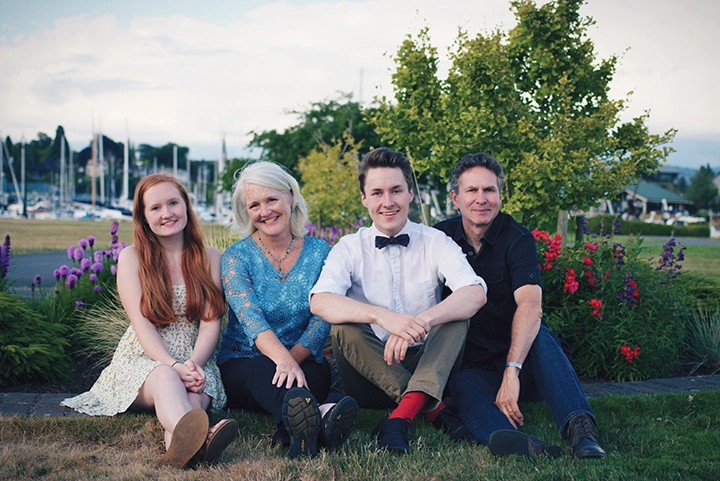By Scott McNutt

How can you forgive someone for the accident that took your leg?
Colleen Haggerty has a full life as a wife, mother, successful author, coach, and speaker. However, until she let go of a grievous wrong in her early life, she couldn’t begin living fully.
Haggerty, then 17, was standing next to her sister’s car on a snowy roadside when a speeding driver slammed into her with such force that it detached her left leg above the knee. Although she healed physically, went on to earn a college degree, pursued activities such as kayaking and backpacking, and presented herself as an upbeat young woman, showing the world a brave face didn’t quiet her inner turmoil. Inside, she was angry and bitter—resentful that she lived with an amputation and constant pain. She desired vengeance on the man who had victimized her, who hadn’t even apologized to her.
After struggling through her 20s to connect emotionally in serious relationships, she began trying to address unresolved feelings in therapy. Still, it was an impulsive act in a moment of anger that provided a path to healing: On the 15th anniversary of the accident, she decided to call Harvey, the driver who had taken her leg, and tell him what his actions had done to her life.
“I wanted to pummel him with words,” Haggerty recalls. “I wanted him to feel the pain I’d felt for 15 years.”
She eventually reached Harvey, and he agreed to meet her.

Image courtesy of Colleen Haggerty.
Haggerty planned to make Harvey feel his impact on her life. But when they met and talked about the accident, her perception of this person—who, in her mind, had stayed frozen in time as the speeding jerk who cost her her leg—began to transform. She learned that guilt haunted Harvey for what he did to her. To Haggerty’s surprise, she felt empathy for him.
“Seeing his pain and what he was holding on to, my understanding of the pain of humanity increased,” she says. It moved her to forgive Harvey’s reckless action, which also helped to resolve many of her own feelings.
“It opened up my heart, it allowed me to see my own humanity, that I’m more than a victim of what happened to me,” she explains. “I felt more like a victor. I felt like I had won the lottery.”
Forgiving Harvey also gave Haggerty perspective on her bottled-up emotions, enabling her to work toward resolving the anger and resentment she felt.
“I released my bitterness and blame and vindictiveness and allowed myself to let it go,” she says. “When I finally opened up myself to that, it was a year later that I finally met my husband.” Together, they have gone on to raise a family.

Through forgiving Harvey, Haggerty gained insight about the process of forgiving. To begin, she suggests taking baby steps, first by being compassionate with yourself. Next, acknowledge your feelings and truly feel them. If you can feel them, you can release them and move past their trigger. She also advocates not viewing forgiveness as letting someone who wronged you “off the hook.” Instead, forgiveness lets you off the hook—the hooks that negative feelings have embedded in you, hooks that can prevent you from moving forward in life.
As Haggerty says, “I forgave Harvey, but what was so much more important was that I released my bitterness….”
With that, she could begin to live her life.
For more information, visit www.colleenhaggerty.com.
HOW DO I FORGIVE LIFE FOR MY AMPUTATION?
Unlike Haggerty’s case, the majority of amputations in the United States result from complications of diseases such as diabetes, peripheral artery disease, and cancer. Therefore, to forgive the agent of our amputation, we must forgive life. But how do we do that?
Frederic Luskin, PhD, director of the Stanford Forgiveness Projects and author of Forgive for Good, has studied the concept of forgiveness extensively. He developed a secular approach to incorporating forgiveness into daily routines to improve quality of life. Following is a brief primer on how to begin practicing existential forgiveness—forgiveness of life.
First, consider the practice of forgiveness in terms of stress management:
“Think about forgiveness as one way of modulating the stress of being upset all the time,” Luskin explains. “Instead of being upset 20 times a week at something you can’t change, you calm down, you get perspective, you look for the good, and you don’t try to make trouble for yourself.”
So, while we can’t do anything about having had a limb amputated, we can take charge of our response to it. This leads to Luskin’s next point, which is to change the narrative around what has occurred. We must see ourselves less as victims of a special hurt, and more as one person among many, all of whom have suffered. If we can let go of feeling like special victims and understand that our wound doesn’t give us an exclusive patent on pain—because everyone has their own pain—we may be able to take the next step.
That step is to gain a broader perspective on our situation. This means, for example, letting go of a focus on negativity. If we can see that life still holds positive things, such as family and love, we can learn to value it more.
If we can do that, it may be possible to make peace with life. Instead of nursing a grudge against life for all the ways it has hurt us, we can forgive it and come to terms with life being the way it is.
According to Luskin, practicing secular forgiveness yields benefits similar to those of stress management, including lowering blood pressure and reducing anxiety, muscle tension, anger, and the perception of pain.
For more information, visit http://learningtoforgive.com.



